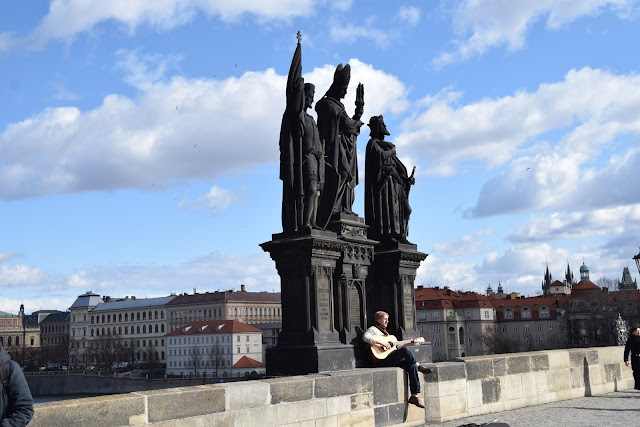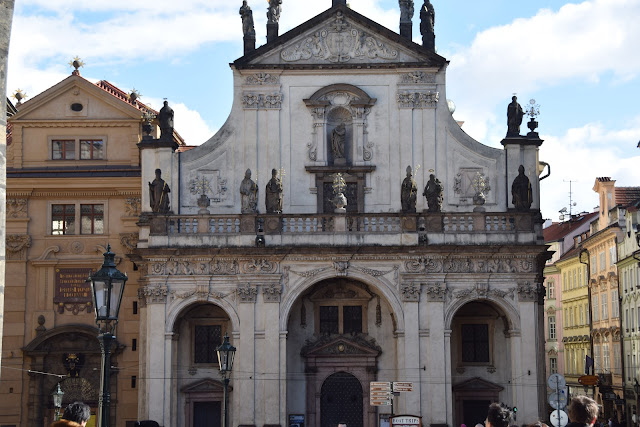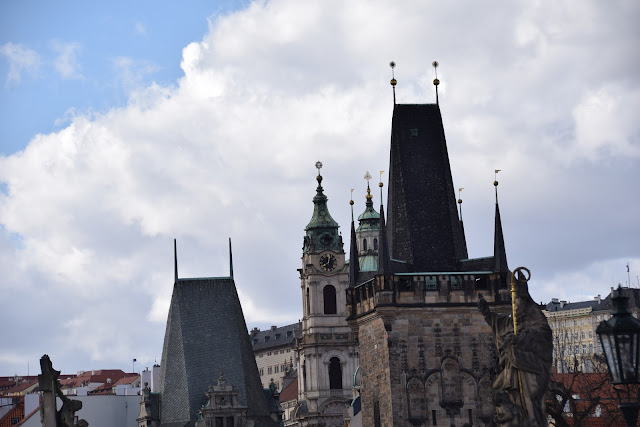Yesterday, we walked from our hotel on top of the hill near the castle, down through the Little Town, Mala Strana (basically Baroque), over the Charles Bridge, though the Old Town (Stare Mesto) to the edge of the New Town (Nove Mesto). In the morning, we passed by one of the largest churches in Prague, the monumental St Nicholas Church, that sits very near the Charles Bridge. It is a huge and incredibly imposing church. It is just about the most over-the-top High Baroque Church I have ever seen. Pictures don't really show its magnitude. It is overwhelmingly large and highly ornate.
It was built for the Jesuits by the Dietzenhofer family, father and son, between 1703 and 1761. The upper cupola is so high, the congregants were afraid it would fall on them. The church borrows Baroque principles from Borromini and Bernini but extends them into ever more complicated spatial programs. Every square inch seems to be decorated.
After seeing the church we crossed the Charles Bridge, walked through the Old Town (Stare Mesto), one Baroque house after another, interspersed with the occasional Renaissance and Gothic. (No Historicism here; this is pure Historic.) We found ourselves near the National Theater on the embankment. And all of a sudden, we realized we were at the beginning of a row of the most amazing Art Nouveau, Secessionist houses. We had read that there was Secession in Prague, but all the guide books mentioned the same buildings I had no idea there would be so much, and that it would be so concentrated. Apparently there was a move to "clean up" Prague at the turn of the century in the urban renewal that many European cities went through around that time. In Prague, over 600 buildings were razed. (This was, as you might expect, a controversial action, because what got torn down was more historic architecture.) So we kept coming on areas where Secession buildings were clustered. But the ones on the Masyrak Embankment were something special, all lined up one after another.

There they were: one amazing building after another.
And filled with the most beautiful and unexpected details.
I probably could--if I spent several years of intense study--learn to "read" the Baroque St. Nicholas, but for whatever reason, it doesn't call me. I first saw Art Nouveau or Secession architecture when I was in Timisoara Romania. Before I saw it there, I really didn't know it existed. And so for me, there has always been this powerful sense of discovery, which is intensified by the fact that, except for the most famous buildings, one tends to stumble onto Art Nouveau architecture. It surprised me that there was so much in such an old city like Prague. But I kept seeing it, and everytime I did, it was like "Hello!"
Walking around Prague is the most intense "architecture experience" I have ever had. More so even than beautiful cities like Paris or Rome, because here there is virtually nothing except stone. No green spaces or wide boulevards. Just lots of buildings crowded side by side, separated by narrow cobblestone streets, plus of course the bridges (which are also sculpted like buildings). (And the fact that it's jammed with tourists only adds to the almost claustrophobic sense of abundance.) I have taken about 2000 pictures since I got here, and I know there are too many. How does one every make sense of so many pictures? How does one make sense of a city like this? It seems a life-long project, but not, alas, for me.
#Prague
#architecture
#Baroque
#ChurchofSaintNicholas
#secession
#Art Nouveau
# MasyrakEmbankment























































